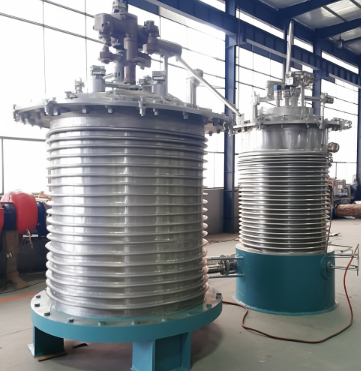
Privacy statement: Your privacy is very important to Us. Our company promises not to disclose your personal information to any external company with out your explicit permission.


| Selling Units: | Others |
|---|

Carbon steel jacketed reactor
Carbon Steel Jacketed Reactor is a robust pressure vessel engineered with precision pressure vessel design. It belongs to a category of Chemical Reactor Types suited for a wide range of applications. The Reaction Vessel Materials include high-quality carbon steel, complemented by an outer jacket often made of stainless steel for enhanced durability and corrosion resistance. This reactor leverages the strength of carbon steel for structural integrity while stainless steel provides superior protection against harsh chemicals and temperature fluctuations.

Key Features:
High-Quality Carbon Steel Construction:
The reactor is built using high-quality carbon steel, which provides excellent strength and durability.
Carbon steel is resistant to high temperatures and pressures, making it suitable for demanding processing environments.
The material's corrosion resistance ensures a long service life, even when handling aggressive chemicals.
Jacketed Design for Temperature Control:
The jacketed reactor features a double-walled design with a space between the inner and outer walls.
This space can be filled with a heating or cooling medium, such as steam, water, or oil, to maintain the desired temperature within the reactor.
Temperature control is crucial for many chemical reactions, as it can affect reaction rates, product yield, and quality.
Versatile and Customizable:
The Carbon Steel Jacketed Reactor can be customized to meet specific process requirements.
Options include various agitator types, materials of construction, and configurations to suit different applications.
The reactor can also be equipped with accessories such as baffles, thermowells, and level indicators to enhance its functionality.
Efficient Mixing and Reaction:
The reactor is equipped with a powerful agitator that ensures efficient mixing of reactants.
Proper mixing is essential for achieving uniform temperature and concentration distributions within the reactor, which can improve reaction kinetics and product quality.
The agitator design can be tailored to the specific needs of the process, such as high-shear mixing or gentle agitation.
Safety and Compliance:
The reactor is designed and manufactured in accordance with industry standards and regulations.
Safety features such as pressure relief valves, temperature sensors, and level controls are incorporated to ensure safe operation.
The reactor can be certified for use in hazardous locations, as required by local regulations.
Easy Maintenance and Operation:
The reactor is designed for easy access and maintenance.
Components such as agitators, seals, and heating/cooling jackets can be easily removed and replaced as needed.
The reactor's control system is user-friendly and can be integrated with automated process control systems for efficient operation.


Applications:
Chemical Synthesis:
Synthesis of organic and inorganic compounds.
Polymerization reactions.
Catalytic reactions.
Pharmaceutical Production:
Synthesis of active pharmaceutical ingredients (APIs).
Intermediate and bulk drug production.
Formulation and processing of pharmaceutical dosage forms.
Food and Beverage Processing:
Cooking and blanching of food products.
Pasteurization and sterilization processes.
Extraction and concentration of food components.
Biotechnology:
Fermentation processes.
Cell culture and tissue engineering.
Enzyme production and purification.
Custom Chemical Processing:
Custom synthesis of specialty chemicals.
Research and development of new chemical processes.
Pilot-scale production for scale-up to commercial manufacturing.


Operation and Maintenance:
Operation:
Adherence to safe operating procedures and protocols.
Monitoring of process parameters such as temperature, pressure, level, and agitation speed.
Regular inspection and cleaning of the reactor and its components.
Proper handling and disposal of hazardous materials and waste.
Maintenance:
Regular maintenance schedules to ensure the reactor and its components are in good working condition.
Inspection and replacement of agitators, seals, and gaskets as needed.
Cleaning and inspection of heating/cooling jackets and piping systems.
Calibration and maintenance of controls and instrumentation.
Troubleshooting:
Identification and resolution of process issues or malfunctions.
Use of diagnostic tools and techniques to pinpoint the source of problems.
Collaboration with manufacturers or service providers for complex troubleshooting and repairs.
Safety and Compliance:
Compliance with industry standards and regulations for reactor operation and maintenance.
Regular safety audits and inspections to ensure the reactor meets safety requirements.
Training and education of operators on safety procedures and emergency response plans.

The file is encrypted. Please fill in the following information to continue accessing it


Privacy statement: Your privacy is very important to Us. Our company promises not to disclose your personal information to any external company with out your explicit permission.

Fill in more information so that we can get in touch with you faster
Privacy statement: Your privacy is very important to Us. Our company promises not to disclose your personal information to any external company with out your explicit permission.